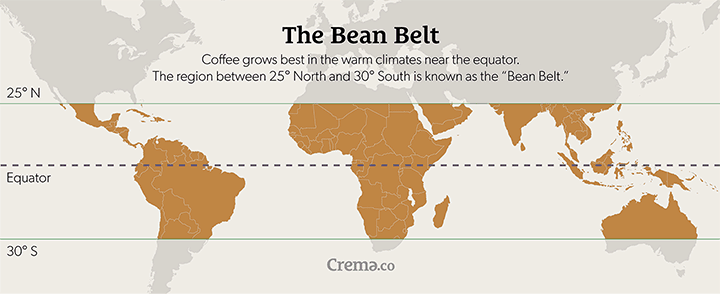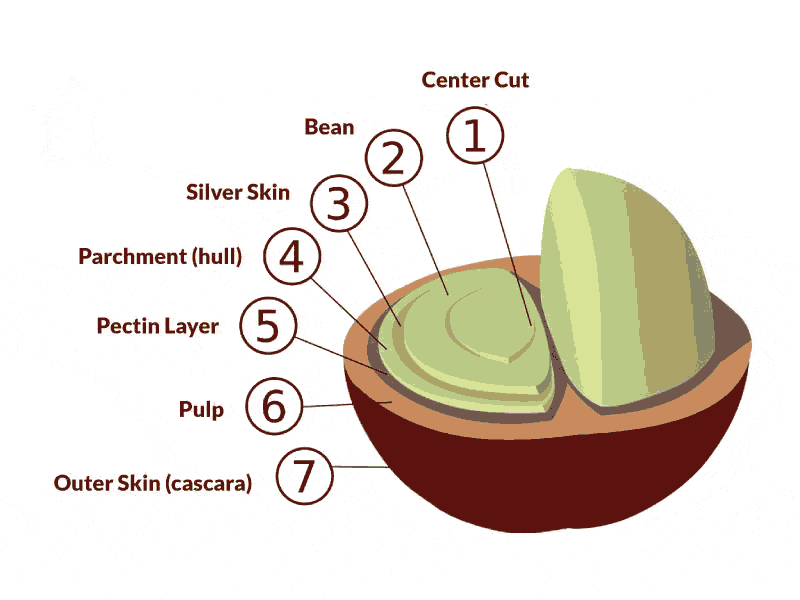I was doing some research for an article about potential coffee extinction when I came across a few species of coffee that were new to me. And I wondered how many Coffea species there actually were. I started digging and boy was I surprised at the answer!
Although the vast majority of the world’s commercial coffee production is either Arabica (Coffea arabica), which accounts for almost 70% or Robusta (Coffea Canephora), which accounts for almost 30%, there are actually 124 coffee species known to science, many of which are found only in the wild.
It’s All Just Coffee
That’s right… as of May 2019, there are 124 separate known coffea species! Coffee grows only on Earth (as far as we know) and almost exclusively in the tropics. The “coffee belt” is generally considered to lie between 25º north latitude and 30º south latitude and coffee is now grown in at least 90 countries. The naturally occurring (wild) coffee strains are mostly found in tropical Africa, the Islands of the Indian Ocean, Asia, and Australasia.

Although there are 124 species, the coffee bean morphology (shape and structure) is largely the same.
Now, coffee is not actually a bean… I went into this topic at some length in a previous post. A coffee bean is actually the seed of the coffee fruit (it’s not actually a fruit, either… it’s a “drupe,” but let’s not get too carried away)

The fruit grows on a coffee tree (which is actually not a tree: it’s technically a shrub… I know. I’m being pedantic, but isn’t that why we are all here?). The fruit is made up of the skin, a thin layer of pulp, a seed coat, and a seed that is generally in two halves, although sometimes it is a single caracol or “peaberry.” As I said, across the species, this is what you will find. But there are differences.
Vive La Difference
Although there are many similarities, there are differences between the species. Sometimes the differences are subtle, as in leaf structure or leaf distribution. Sometimes the differences are easy to spot: Some species produce more than others and the color of the fruit can vary from yellow to orange to red to dark purple. The size of the fruit and seed can vary from 5 mm of the Coffea racemose to the 20 mm of the C. ambongenis. There is even a variety, C. namorokensis, that produces a hairy fruit.
Useful Traits
The genetic diversity of the wild species of coffee are important because some of them have desirable characteristics that might be useful as growing conditions change due to climate shifts. A drought resistant species might just come in handy. In the late 1800s, almost all the Arabica trees in Java were wiped out by coffee rust, but the hardy Robusta tree has come a long way toward rebuilding the coffee industries of Indonesia.<LINK> Other varieties have other pest and disease resistance.
It is probably not surprising that the caffeine content can vary from species to species. In fact, C. racemose has a caffeine content so low that it is naturally as low as decaffeinated coffee!
The big thing for me is taste. It is for most other people, as well. Arabica has been the king of that particular mountain for many years, but researchers are always looking for ways to produce a better cup. Besides, as we learned earlier, Arabica is susceptible to coffee rust and we don’t want to face a world without good coffee.
Arabica
The first cultivated species of coffee tree and the most widely grown due to its superior flavor and good production. Approximately 70% of the world’s coffee production, and all the best tasting coffees, are Arabica (C. arabica). There are dozens of varieties and cultivars of Arabica.
Robusta
About 27% of the world’s coffee is Robusta (C. canephora). It is a lower-growing, higher-bearing tree and produces coffee that has higher caffeine content and inferior cupping quality to Arabica. Because it is lower growing, on flatter land, it is more suitable for mechanical cultivation, allowing for economies of scale making it less expensive to produce. It is used in blends of instant coffee, and for less expensive blends of ground commercial coffee. Some blenders claim that combining it with Arabica beans gives more body to a cup of espresso.
Other Notable Coffees
Eugenioides coffee (C. eugenioides) is indigenous to the highlands of East Africa, including the Democratic Republic of Congo, Rwanda, Uganda, Kenya and western Tanzania. It has a lower caffeine content than Arabica.
Liberica (C. Liberica) grows much taller and has larger fruits than Arabica, although the per tree yield is lower. The coffee “beans” are often irregular in shape. Liberica trees were brought to Indonesia to replace the Arabica trees killed by coffee rust. Excelsa is a popular varietal of Liberica.
A Complete Alphabetical List of
All Coffee Species
- Coffea abbayesii
- Coffea affinis
- Coffea alleizettii
- Coffea ambanjensis
- Coffea ambongenis
- Coffea andrambovatensis
- Coffea ankaranensis
- Coffea anthonyi
- Coffea arabica
- Coffea arenesiana
- Coffea augagneurii
- Coffea bakossii
- Coffea benghalensis
- Coffea bertrandii
- Coffea betamponensis
- Coffea bissetiae
- Coffea boinensis
- Coffea boiviniana
- Coffea bonnieri
- Coffea brassii
- Coffea brevipes
- Coffea bridsoniae
- Coffea buxifolia
- Coffea canephora (“Coffea robusta”)
- Coffea carrissoi
- Coffea charrieriana
- Coffea cochinchinensis
- Coffea commersoniana
- Coffea congensis
- Coffea costatifructa
- Coffea coursiana
- Coffea dactylifera
- Coffea decaryana
- Coffea dubardii
- Coffea ebracteolata
- Coffea eugenioides
- Coffea fadenii
- Coffea farafanganensis
- Coffea floresiana
- Coffea fotsoana
- Coffea fragilis
- Coffea fragrans
- Coffea gallienii
- Coffea grevei
- Coffea heimii
- Coffea homollei
- Coffea horsfieldiana
- Coffea humbertii
- Coffea humblotiana
- Coffea humilis
- Coffea jumellei
- Coffea kapakata
- Coffea kianjavatensis
- Coffea kihansiensis
- Coffea kimbozensis
- Coffea kivuensis
- Coffea labatii
- Coffea lancifolia
- Coffea lebruniana
- Coffea leonimontana
- Coffea leroyi
- Coffea liaudii
- Coffea liberica
- Coffea ligustroides
- Coffea littoralis
- Coffea lulandoensis
- Coffea mabesae
- Coffea macrocarpa
- Coffea madurensis
- Coffea magnistipula
- Coffea malabarica
- Coffea mangoroensis
- Coffea mannii
- Coffea manombensis
- Coffea mapiana
- Coffea mauritiana
- Coffea mayombensis
- Coffea mcphersonii
- Coffea melanocarpa
- Coffea merguensis
- Coffea millotii
- Coffea minutiflora
- Coffea mogenetii
- Coffea mongensis
- Coffea montekupensis
- Coffea montis-sacri
- Coffea moratii
- Coffea mufindiensis
- Coffea myrtifolia
- Coffea namorokensis
- Coffea neobridsoniae
- Coffea neoleroyi
- Coffea perrieri
- Coffea pervilleana
- Coffea pocsii
- Coffea pseudozanguebariae
- Coffea pterocarpa
- Coffea racemosa
- Coffea rakotonasoloi
- Coffea ratsimamangae
- Coffea resinosa
- Coffea rhamnifolia
- Coffea richardii
- Coffea sahafaryensis
- Coffea sakarahae
- Coffea salvatrix
- Coffea sambavensis
- Coffea sapinii
- Coffea schliebenii
- Coffea semsei
- Coffea sessiliflora
- Coffea stenophylla
- Coffea tetragona
- Coffea togoensis
- Coffea toshii
- Coffea travancorensis
- Coffea tricalysioides
- Coffea tsirananae
- Coffea vatovavyensis
- Coffea vavateninensis
- Coffea vianneyi
- Coffea vohemarensis
- Coffea wightiana
- Coffea zanguebariae
Conclusion
While there are 124 species of coffee, only two of them make up almost the entire world’s production. There was a recent study pointing out that many of these lesser-known species were at risk, since they only grow in small, specific, geographic areas and that climate change might make it impossible for them to thrive. That ended up being popularly reported as “Coffee is going extinct!” Check out this post for more on that.
While I am not going to give in to hyperbole, losing this genetic diversity would be a very bad thing. Cross-breeding within plant species is a terrific way to combat habitat loss and improve disease resistance.
And I am for anything and everything that guarantees my morning cup is going to continue to hit my breakfast table.
If you like coffee and fun, join us in our Procaffeination Facebook Group. To be among the first to find out when the book is ready (and probably get a discount, too) sign up for the email list. No spam… promise.

